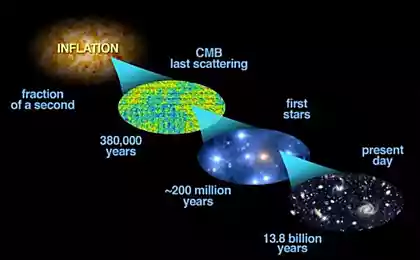529
"Planck" found no gravitational waves

Despite all the rumors about the possible detection of a primary gravitational waves, joint data analysis of the satellite "Planck", owned by the European space Agency, and ground-based experiments BICEP2 and the Keck array have not provided any evidence of their existence. As you know, the universe started about 13.8 billion years ago and has evolved from a very hot, dense and uniform state to the rich and complex cosmos of galaxies, stars and planets that we see today. An extremely important source of information about the history of the Universe is the cosmic microwave background (CMB, the relic radiation), the remains of light, which appeared later, only 380 000 years after the Big Bang.
Satellite "Planck" observed this background across the sky with unprecedented precision, and for the last few years we have learned a lot about the young Universe. But astronomers are digging deeper hoping to go back further in time: they are searching a particular signature of cosmic "inflation" — a short period of accelerated expansion, through which, according to theory, the universe was as young as a few tiny fractions of a second.
This picture shows the area of sky being monitored by satellite "Planck" in millimeter and submillimeter wavelengths. The color scale shows the emission of dust that fills the milky Way. Texture, on the contrary, displays the orientation of the galactic magnetic field. It is based on measurements of the direction of polarized light emitted by dust. The highlighted region shows the position of the small area of the sky, overseen by scientists at the South Pole, BICEP2 and the Keck array, and which suggests the possible detection of a curved B-mod.
This signature should be visible in gravitational waves, tiny perturbations in the fabric of space-time that occurred during the inflationary phase, according to astronomers. Interestingly, these perturbations should leave an imprint on other features of the relic radiation: its polarization.
When light waves vibrate mostly in one direction, we say the light is polarized. The CMB is polarized and shows a complex picture across the sky. It consists of two basic patterns: circular and radial (known as E-modes), and curly (B-modes).
Different phenomena in the Universe produce either E-or B-modes on different angular sizes, and identifying different sources requires extremely accurate measurements. It B-modes could get a prize for identifying the inflation of the young Universe.
"Searching for this unique record of the youngest Universe complex and interesting, since this subtle signal is hidden behind the polarization of the CMB, which itself only represents a few percent of the entire world," says Jan Taube, scientist of the project "plank" in the European space Agency. "Plank" is not alone in this search. In early 2014, another team of astronomers presented results based on observations of the polarized cosmic radiation on a small area of sky in 2010-2012 with the BICEP2 experiment at the South Pole. The team also used preliminary data from another experiment at the South Pole, the array of telescopes Keck.
And they found something interesting: curly B-modes in polarization was observed at parts of the sky several times larger than the size of the full moon. The BICEP2 team put this fact in favor of the interpretation that the signal originated from the primary gravitational waves, and caused a major stir in the scientific community.
However there is another contender in this game that can produce the same effect: interstellar dust in our milky Way galaxy.

This image shows a map of the entire sky, composed of "Planck" at nine frequencies during its first 15.5 is the monthly monitoring
The milky Way is permeated with a mixture of dust and gas and dust shining at similar frequencies to that of the CMB, which significantly hinders the observation of the oldest cosmic light. Required very careful analysis to separate eclipsing cosmic background light. Importantly, interstellar dust also emits polarized light that influences the polarization of the CMB.
"When we first detected this signal in our data, we relied on a model of galactic dust emission that were available at the time, says John Kovac, a BICEP2 principal investigator at Harvard University in the United States. They seemed to show that the region of the sky chosen for our observations, the dust has less polarization than the detected signal". Both ground-based experiment collected data on the same microwave frequency, which makes it difficult to split radiation of the milky Way and background.
On the other hand, the "plank," observed the sky in nine microwave and submillimeter frequency channels, seven of which were also equipped with polarization-sensitive detectors. By careful analysis, these multi-frequency data can be divided according to need.
The BICEP2 team had chosen a field where, in their view, the dust emission should be low, and thus interpreted the signal must be cosmological. However, once the "plank" drew a map of polarized emission of galactic dust, it became clear that its contribution may be higher than expected.
Moreover, in September 2014, the "plank" for the first time showed that the polarized emission is dominated by dust all over the sky, when compared with the signal detected by BICEP2 even in relatively clean regions.
Thus, teams Planck and BICEP2 have joined forces, combining the satellite's ability to deal with foreground emission (due to observations at different frequencies) and greater sensitivity of ground-based experiments in the case of limited sky areas, thanks to their more powerful and modern technologies. By the time a full data array of the Cake for 2012 and 2013.
"This joint work has shown that detection of primary B-mod is not so confident, when we remove the emission of galactic dust, says Jean-Loup Pure, principal investigator of the HFI instrument of the satellite Planck Institute for astrophysics in Orsay, France. — Unfortunately, we are unable to confirm that this signal is the imprint of cosmic inflation." Another source of polarization B-modes, which is rooted in the young Universe, were identified in the study, but on a much smaller scale the sky.
This signal, first discovered in 2013, is not a direct symptom of the inflationary phase, but is induced by a cosmic network of massive structures that fill the Universe and changing the path of the photons of the CMB on the way to us.

This image demonstrates how the photons of the cosmic microwave background (CMB) scattered by the gravitational lensing of massive space structures along the road across the Universe
This effect is called "gravitational lensing" because it occurs when massive objects bend the surrounding space and bend the trajectory of light as if it passes through a magnifying glass. This signal is detected together "Planck", BICEP2 and the Keck array, is still the strongest. But as signs of the inflationary period, the question remains open.
"Although we have not found convincing evidence of a primary signal of gravitational waves among the best of the currently available observations of the polarization of the CMB, this does not negate inflation," says Reno Mandolesi, principal investigator of the LFI instrument on "the limit" from the University of Ferrara in Italy. The joint study found the upper limit on the amount of gravitational waves from inflation, which may have been formed during this period, but not enough to confirm it in accordance with this analysis.
"This analysis shows that the number of gravitational waves, may not exceed half of the observed signal, says Clem Pric, chief investigator of BICEP2 at the University of Minnesota. — New upper limit of the signal agrees well with the upper limit obtained earlier with the "Planck" based on the temperature fluctuations of the CMB. The signal of gravitational waves could still be there, and the search will definitely continue."
Source: hi-news.ru
Your Incarnation Cross and Profile – Your purpose and Suit Life
Alastair Bonnette on political geography of the future























